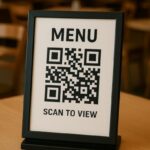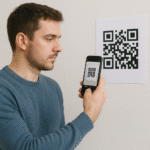
How Dynamic QR Codes Are Transforming Marketing & Campaigns in 2025
Posted in :
Introduction: The Marketing Revolution You Can’t Ignore
Static QR codes were just the beginning. In 2025, dynamic QR codes have emerged as the secret weapon of sophisticated marketing campaigns, enabling real-time optimization, personalized experiences, and unprecedented campaign intelligence that static codes simply cannot deliver.
While traditional QR codes remain fixed forever, dynamic QR codes offer marketers something revolutionary: the power to change destinations, track performance, and optimize campaigns without reprinting a single piece of marketing material. This flexibility has transformed how leading brands approach customer engagement, campaign measurement, and marketing ROI.
This comprehensive guide reveals how forward-thinking marketers are leveraging dynamic QR technology to create campaigns that adapt, learn, and improve in real-time.
Understanding Dynamic vs. Static QR Codes
The Fundamental Difference
Static QR Codes:
- Fixed destination URL encoded directly in the code
- Cannot be changed once generated
- No tracking capabilities
- Free but limited functionality
Dynamic QR Codes:
- Redirect through a short URL that can be updated
- Destinations changeable anytime without reprinting
- Comprehensive analytics and tracking
- Campaign optimization capabilities
Why Dynamic Codes Are Game-Changers
The ability to modify destinations post-publication eliminates the costly risk of marketing material becoming obsolete. A billboard campaign running for three months can promote different products, seasonal offers, or targeted landing pages throughout its duration—all using the same printed QR code.
Real-World Campaign Transformations
Case Study: Global Fashion Retailer’s Seasonal Strategy
The Challenge: A major fashion brand printed 500,000 product catalogs with QR codes linking to their spring collection. Traditionally, these catalogs became outdated when summer inventory arrived.
The Dynamic Solution: Using dynamic QR codes, they seamlessly transitioned the same printed codes from spring to summer to fall collections, extending catalog usefulness by 300% and saving $2.3 million in reprinting costs.
Results:
- 85% increase in scan-to-purchase conversion
- 40% higher engagement rates across seasons
- $8.7 million additional revenue from extended catalog life
Case Study: Restaurant Chain’s Location-Based Marketing
The Innovation: A national restaurant chain uses dynamic QR codes on delivery packaging that automatically detect the customer’s location and redirect to the nearest franchise’s specific menu and promotions.
The Impact:
- 60% increase in repeat orders
- 45% improvement in local promotion uptake
- 25% reduction in customer service inquiries about local offers
Case Study: Event Marketing Evolution
The Transformation: A major conference series uses dynamic QR codes on promotional materials that evolve throughout the marketing timeline:
- 6 months before: Early bird registration
- 3 months before: Speaker announcements
- 1 month before: Schedule and logistics
- During event: Live updates and networking
The Results:
- 90% improvement in pre-event engagement
- 70% increase in attendee satisfaction scores
- 50% reduction in event app development costs
Advanced Dynamic QR Marketing Strategies
Time-Based Campaign Optimization
Morning Coffee, Evening Dining Smart restaurants use dynamic QR codes that automatically switch between breakfast, lunch, and dinner menus based on time of day, increasing relevant order volume by 35%.
Seasonal Product Rotation Retail brands program dynamic codes to automatically shift from winter to spring merchandise as seasons change, maintaining campaign relevance without manual intervention.
Flash Sale Activation E-commerce brands can instantly convert all printed materials into flash sale promotions by updating dynamic QR destinations across thousands of touchpoints simultaneously.
Geographic Personalization
Location-Aware Campaigns Dynamic QR codes can detect user location and redirect to region-specific content, local store information, or geographically relevant promotions.
Multi-Market Testing Brands can test different landing pages, offers, or messaging across geographic regions using the same QR code, optimizing performance based on local preferences.
International Campaign Management Global brands use dynamic codes that automatically redirect users to country-specific websites with appropriate language, currency, and local offers.
Audience Segmentation Through QR Analytics
Behavioral Targeting Advanced dynamic QR systems track user behavior patterns, enabling personalized retargeting and customized follow-up campaigns based on scan history.
Device-Specific Optimization Dynamic codes can detect device types and redirect mobile users to app downloads while desktop users go to full websites, optimizing conversion paths.
Demographic-Based Routing Integration with customer databases allows dynamic QR codes to provide personalized experiences based on known customer preferences and purchase history.
Analytics and Performance Measurement
Real-Time Campaign Intelligence
Instant Performance Metrics Dynamic QR platforms provide real-time data on:
- Scan volumes and timing patterns
- Geographic distribution of engagement
- Device and browser analytics
- Conversion tracking and ROI measurement
A/B Testing Capabilities Marketers can split-test different destinations using the same QR code, directing portions of traffic to different landing pages to optimize conversion rates.
Campaign Attribution Advanced tracking reveals which marketing channels and materials generate the highest-value QR code scans, enabling better budget allocation.
Key Performance Indicators (KPIs)
Engagement Metrics
- Scan rate: Percentage of exposures resulting in scans
- Time to scan: How quickly audiences engage with codes
- Return scan rate: Repeat engagement measurement
Conversion Metrics
- Scan-to-action rate: Percentage completing desired actions
- Revenue per scan: Average value generated per engagement
- Customer lifetime value from QR acquisition
Campaign Efficiency
- Cost per scan: Marketing spend efficiency measurement
- Campaign reach: Unique users engaged across touchpoints
- Cross-channel attribution: QR impact on other marketing channels
Advanced Analytics Applications
Predictive Campaign Optimization Machine learning algorithms analyze scan patterns to predict optimal timing, content, and targeting for future campaigns.
Seasonal Trend Analysis Historical QR data reveals seasonal engagement patterns, enabling proactive campaign planning and inventory management.
Competitive Benchmarking Industry QR performance standards help marketers understand relative campaign effectiveness and identify improvement opportunities.
Platform Selection and Technical Implementation
Essential Dynamic QR Features
Campaign Management Dashboard Centralized control for managing multiple QR campaigns, updating destinations, and monitoring performance across all marketing materials.
Advanced Analytics Suite Comprehensive reporting tools providing actionable insights into campaign performance, audience behavior, and optimization opportunities.
Integration Capabilities Seamless connection with existing marketing tools, CRM systems, and analytics platforms for unified campaign management.
Security and Reliability Considerations
Link Protection Enterprise-grade dynamic QR platforms provide malware scanning, SSL encryption, and fraud protection to maintain brand safety.
Uptime Guarantees Reliable platforms offer 99.9% uptime guarantees ensuring QR campaigns remain functional during critical marketing periods.
Backup and Recovery Robust systems include automatic backups and instant failover capabilities to prevent campaign disruption.
Industry-Specific Dynamic QR Applications
Retail and E-commerce
Inventory-Linked Promotions Dynamic QR codes automatically update to promote in-stock items while hiding out-of-stock products, maintaining campaign relevance and reducing customer frustration.
Price Optimization Real-time price adjustments through dynamic QR codes enable instant competitive responses and demand-based pricing strategies.
Personalized Shopping Experiences Customer recognition systems provide personalized product recommendations and exclusive offers through dynamic QR interactions.
Healthcare and Pharmaceuticals
Patient Education Updates Medical practices use dynamic QR codes on patient materials that can be updated with the latest treatment information, safety updates, or appointment scheduling.
Medication Information Pharmaceutical companies provide up-to-date drug information, side effect warnings, and patient resources through dynamic QR codes on packaging.
Telehealth Integration Healthcare providers use dynamic QR codes that route patients to appropriate telehealth platforms based on appointment type and provider availability.
Real Estate and Property
Listing Management Real estate agents use dynamic QR codes on property signs that automatically update with current pricing, availability, and virtual tour links.
Multi-Property Campaigns Property developers use single QR codes that showcase different available units based on buyer preferences and availability.
Market Adaptation Real estate marketing materials can instantly pivot between rental and sale promotions based on market conditions without reprinting.
Event and Entertainment
Dynamic Ticket Sales Event promoters use QR codes that automatically switch between early bird, regular, and last-minute pricing without changing promotional materials.
Performer Updates Music venues and festivals update QR codes with lineup changes, schedule modifications, and exclusive content throughout promotion periods.
Capacity Management Dynamic QR codes can redirect to waitlists when events sell out, capturing interested attendees for future opportunities.
Future Trends and Innovations
AI-Powered Campaign Optimization
Intelligent Content Switching Artificial intelligence analyzes real-time performance data to automatically switch QR destinations to highest-converting content without human intervention.
Predictive Audience Targeting Machine learning algorithms predict optimal timing and content for individual users based on historical scan behavior and conversion patterns.
Automated Campaign Scaling AI systems automatically expand successful QR campaigns across additional marketing channels and touchpoints based on performance thresholds.
Augmented Reality Integration
Interactive Brand Experiences Dynamic QR codes serve as triggers for personalized AR experiences that adapt based on user preferences and campaign objectives.
Product Visualization Retail brands use dynamic QR codes to provide AR product demonstrations that update with new features and seasonal variations.
Location-Based AR Content Dynamic codes deliver different AR experiences based on physical location, creating contextually relevant brand interactions.
Voice and Conversational Integration
Voice Assistant Connectivity Dynamic QR codes can trigger voice-activated experiences through smart speakers and mobile voice assistants for hands-free brand interaction.
Chatbot Integration Advanced dynamic QR systems launch personalized chatbot conversations tailored to specific campaigns and user characteristics.
Implementation Best Practices
Campaign Planning and Strategy
Clear Objective Definition Successful dynamic QR campaigns begin with specific, measurable goals that guide destination selection and optimization strategies.
Multi-Touch Attribution Design campaigns that track QR interactions across multiple touchpoints to understand complete customer journey impact.
Contingency Planning Prepare backup destinations and alternative content for different scenarios, including high traffic periods and technical issues.
Creative and Design Considerations
Visual Consistency Maintain brand consistency while ensuring QR codes remain scannable across all marketing materials and contexts.
Call-to-Action Optimization Clear, compelling instructions increase scan rates and set appropriate expectations for the resulting experience.
Mobile-First Design Ensure all dynamic QR destinations provide excellent mobile experiences since most scans occur on smartphones.
Performance Monitoring and Optimization
Regular Analytics Review Establish weekly performance reviews to identify optimization opportunities and campaign improvements.
Continuous Testing Implement ongoing A/B tests for destinations, offers, and user experiences to maximize campaign effectiveness.
Seasonal Adjustments Plan and implement seasonal content updates to maintain campaign relevance throughout extended marketing periods.
Getting Started with Dynamic QR Marketing
Choosing the Right Platform
When selecting a dynamic QR platform, consider:
- Analytics depth and reporting capabilities
- Integration options with existing marketing tools
- Scalability for growing campaign needs
- Security features and reliability guarantees
- Cost structure and pricing model
Building Your First Campaign
Step 1: Define Objectives Establish clear, measurable goals for your dynamic QR campaign including desired actions and success metrics.
Step 2: Design User Journey Map the complete experience from QR scan through conversion, ensuring seamless transitions and clear value propositions.
Step 3: Implement Tracking Set up comprehensive analytics to monitor performance and identify optimization opportunities.
Step 4: Launch and Optimize Begin with conservative targeting, then expand and optimize based on real performance data.
Measuring Success and ROI
Revenue Attribution Track direct revenue generated through QR interactions, including both immediate and influenced purchases.
Customer Acquisition Costs Calculate the cost-effectiveness of QR campaigns compared to other marketing channels.
Lifetime Value Impact Measure the long-term value of customers acquired through dynamic QR campaigns.
Conclusion: The Dynamic Advantage
Dynamic QR codes represent more than an incremental improvement over static codes—they’re a fundamental shift toward intelligent, adaptive marketing that responds to real-world performance and customer behavior. In 2025, the most successful campaigns are those that can evolve, optimize, and personalize experiences in real-time.
The brands achieving extraordinary results with dynamic QR marketing share common characteristics: they think strategically about user experiences, measure performance rigorously, and optimize continuously based on data-driven insights.
As marketing continues evolving toward personalization and real-time optimization, dynamic QR codes provide the bridge between physical marketing materials and digital experiences that can adapt, improve, and deliver measurable results.
Ready to transform your marketing campaigns? While many dynamic QR platforms require subscriptions and complex setups, you can start experimenting with QR marketing using QRCodeMyURL.com to understand the fundamentals before investing in advanced dynamic solutions.
Create Your First Marketing QR Codes →
Advanced Resources
- Dynamic QR Campaign Templates – Ready-to-use campaign frameworks for different industries
- QR Analytics Mastery Guide – Advanced techniques for campaign measurement and optimization
- Multi-Channel QR Integration – Connecting QR campaigns with email, social, and paid advertising
- QR Security Best Practices – Protecting campaigns and customer data in dynamic QR implementations
Disclaimer: This analysis focuses on dynamic QR code capabilities and strategies. Individual platform features and pricing may vary. Always verify specific functionality before committing to enterprise campaigns.

